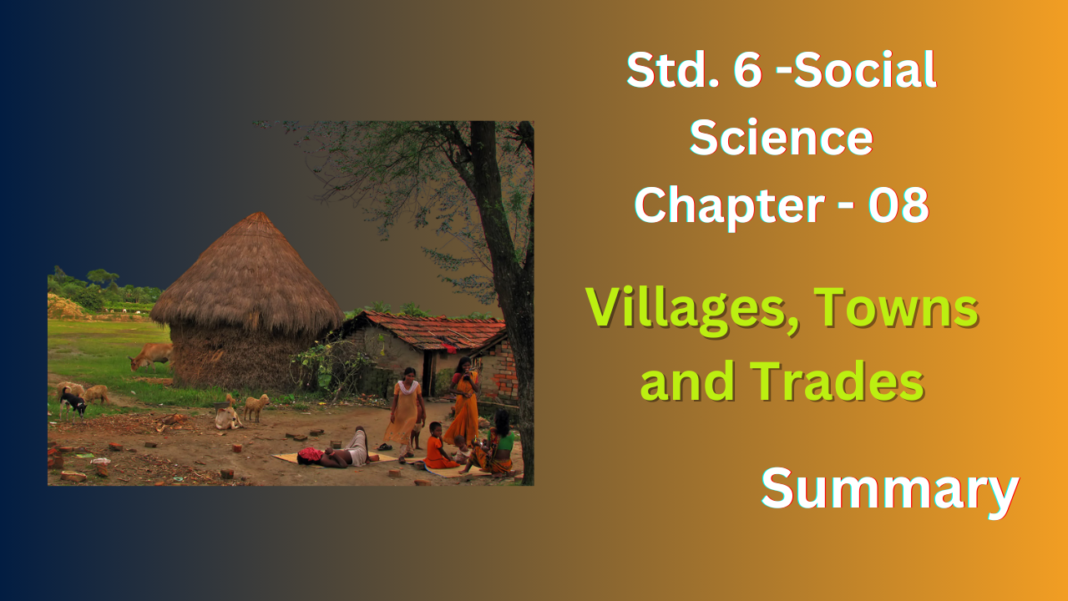NCERT Solutions for Class 6 History Chapter 8
The chapter Villages Towns and Trades explores the lives of people in ancient India, focusing on the difference between villages and towns:
Villages:
- Small settlements: Villages were small, self-sufficient communities where most people were farmers.
- Focus on agriculture: Farmers grew crops like rice, wheat, and vegetables, and raised animals for food and other products.
- Cooperative living: Villagers often worked together for tasks like cultivation, harvesting, and building projects.
- Simple houses: Homes were typically made of mud bricks, wood, or bamboo, with thatched roofs.
Towns:
- Larger and busier: Towns were larger than villages and had a more diverse population.
- Trade and crafts: People in towns were involved in various activities like weaving, pottery making, and trading goods.
- Specialized roles: Towns had artisans, shopkeepers, and traders who fulfilled specific roles in the economy.
- Planned layouts: Some towns might have had planned layouts with specific areas for markets and workshops.
Trade:
- Connecting communities: The chapter might mention the importance of trade in connecting villages and towns, facilitating the exchange of goods and ideas.
- Transportation: Bullock carts, boats, and even camels might be used for transporting goods over land and water routes.
- Coins: The introduction of coins simplified trade and made transactions easier compared to barter.
NCERT Solutions for Class 6 History Chapter 8
Let’s recall
1. Fill in the blanks:
(a)____was a word used for large landowners in Tamil.
(b) The gramabhojaka often got his land cultivated by the___.
(c) Ploughmen were known as_____Tamil.
(d) Most grihapatis were____landowners.
Ans: (a) Velan
(b) Uzhavar
(c) Ulavar
(d) Small
2. Describe the functions of the gramabhojaka Why do you think he was powerful?
Ans: The Gramabhojaka held a powerful position in ancient Indian villages for several reasons, thanks to the functions they performed:
- Tax Collection: The Gramabhojaka was responsible for collecting taxes from farmers (uzhavar) on behalf of the king or ruler. This gave them control over a significant amount of resources and economic power within the village.
- Judicial Role: In some cases, the Gramabhojaka might have acted as a judge, settling disputes and maintaining order within the village community. This judicial authority gave them influence and respect among the villagers.
- Landownership: The Gramabhojaka was often the largest landowner (Velan) in the village. This land provided them with wealth, a steady income from cultivation, and the ability to employ laborers (uzhavar) further solidifying their power base.
- Social Status: Their position as tax collector, judge, and large landowner placed the Gramabhojaka at the top of the village social hierarchy. This high status commanded respect and deference from other villagers.
3. List the craftspersons who would have in both villages and cities.
Ans : Here’s a list of craftspersons who would have been found in both villages and cities in ancient India:
- Potters: Essential for making pots, storage containers, utensils, and even bricks for houses.
- Weavers: Produced textiles like cloth, ropes, and nets, catering to clothing needs and other practical uses.
- Blacksmiths: Worked with iron and other metals to create tools, weapons, and household implements.
- Carpenters: Crafted furniture, carts, agricultural tools, and other wooden objects.
- Basketmakers: Made baskets, mats, and other woven items from reeds, bamboo, or other plant materials, used for storage, carrying goods, or even as furniture.
4. Choose the correct answer:
(a) Punch marked coins were made of
1. silver
2. gold
3. tin
4. ivory
(b) Mathura was an important:
1. village
2. port
3. religious centre
4. forested area
(c) Shrenis were associations of:
1. rulers
2. craftspersons
3. farmers
4. herders
Ans : (a) 1. Silver
(b) 3. religious centre
(c) 2. craftspersons
5. What kinds of evidence do historians use to find out about trade and trade routes?
Ans : Historians use a variety of evidence to piece together information about trade and trade routes in ancient societies. Here are some key sources:
- Archaeological Finds:
- Artifacts: Unearthed objects like pottery shards, coins, and tools can indicate trade links. Finding a specific type of pottery in a region far from where it was produced suggests trade routes.
- Harbors and Ports: Remains of harbors, docks, and shipwrecks provide clues about the locations and types of trade conducted.
- Beads and Semi-precious Stones: These materials were often lightweight and valuable, making them ideal for trade. Finding them in archaeological sites far from their source indicates trade connections.
- Literary Sources:
- Travel Accounts: Writings by travelers, merchants, or pilgrims can offer firsthand descriptions of trade routes, goods exchanged, and the cultures involved.
- Administrative Records: Records left by rulers or officials might mention taxes collected on trade goods, ports of entry, or regulations governing trade.
- Numismatics (Coin Studies):
- Coins: The presence of coins from different regions in a particular location suggests trade activity. Studying the types of coins, their origin, and inscriptions can reveal trade routes and economic connections.
- Oral Traditions and Folklore:
- Songs and Stories: Folklore and stories passed down through generations might contain references to trade routes, important trading centers, or specific goods exchanged.
Let’s discuss
5. Which of the iron tools shown on page 73 would have been important for agriculture? What would the other tools have been used for?
Ans : Important for Agriculture
Sickle: The curved blade of a sickle is ideal for reaping crops like wheat, barley, or rice.
Other Tools (and their possible uses):
- Axe: Chopping wood for fuel, clearing land for cultivation, or making repairs to tools or fences.
- Hammer: Shaping metal objects, repairing tools, or driving nails/pegs into wood for construction purposes.
- Chisel: Carving wood for tools or implements, creating decorative elements on furniture or buildings.
- Shovel: Moving earth, digging irrigation channels, or preparing planting pits.
- Tongs: Holding hot metal objects while working with a forge or blacksmith.
6. Compare the drainage system in your locality with that of the cities mentioned in the lesson. What similarities and differences do you notice?
Ans : Similarities:
- Purpose: Both ancient and modern drainage systems aim to remove excess water from populated areas to prevent flooding, improve sanitation, and control the spread of diseases.
- Basic principles: Both might use channels or underground pipes to collect and direct water runoff away from houses and streets.
Differences:
Materials:
- Ancient: Drainage systems in Indus Valley cities like Mohenjo-daro were built with baked bricks, stones, and sometimes terracotta pipes.
- Modern: Modern drainage systems typically use concrete, PVC pipes, or other durable materials.
NCERT Solutions for Class 6 History Chapter 8
FAQ’s
What topics are covered in Class 6 History Chapter 8: “Villages, Towns, and Trades”?
Class 6 History Chapter 8 explores the dynamics of ancient settlements, covering topics such as the development of villages and towns, trade networks, and economic activities in ancient civilizations.
How can NCERT solutions for Class 6 History Chapter 8 help in understanding villages, towns, and trades?
NCERT solutions offer detailed explanations and analyses of historical events and concepts related to the development of villages, towns, and trade networks, helping students grasp the complexities of urbanization and economic interactions in ancient societies.
Where can I find NCERT solutions for Class 6 History Chapter 8?
NCERT solutions for Class 6 History Chapter 8 Villages Towns and Trades can be found online or in study materials provided by educational platforms or institutes specializing in academic resources.
When should I refer to NCERT solutions for Class 6 History Chapter 8?
They can be used alongside regular study or as a revision tool before assessments to enhance understanding of the dynamics of ancient settlements and economic activities.
What specific examples are discussed in Class 6 History Chapter 8 regarding villages, towns, and trades?
Class 6 History Chapter 8 discusses various examples of ancient settlements and trade networks, such as the Indus Valley Civilization and the Silk Road, offering insights into the social, cultural, and economic exchanges that shaped ancient civilizations.









